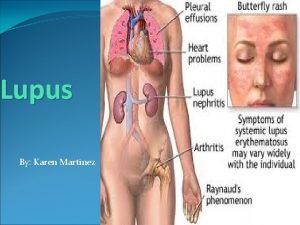Lupus Power Point presentation Raising Lupus Awareness Purpose





















- Slides: 21

Lupus Power. Point presentation: Raising Lupus Awareness

Purpose • By participating in The Playbook: Local Lupus Awareness Activities, you are helping increase lupus awareness in your community. • Increasing lupus awareness and education can result in earlier treatment and subsequently better quality of life for those with the condition. • Increasing lupus awareness and education among young women of color can help mitigate lupus health disparities. 2

DISCUSSION: What have you already seen or heard (if anything) about lupus? • On TV or online » Celebrities with lupus • Signs and symptoms • Who is at risk • Complications 3

What is lupus? • Systemic lupus erythematosus, referred to as SLE or lupus, is a chronic disease, meaning it is a long term disease that should be managed. • Lupus affects the immune system and is called an autoimmune disease. The immune system’s job is to fight foreign invaders, like germs and viruses. But in autoimmune diseases, the immune system is out of control and mistakenly attacks healthy tissue. • Lupus can cause pain, inflammation, and tissue damage to various organs in the body like the kidneys, live, heart, lungs, and brain. • While there is no cure for lupus, medical treatments and lifestyle changes can help control it. 4

What are the signs and symptoms of lupus? Joint pain or swelling Extreme exhaustion Low-grade fevers 5 Mouth sores Rashes

Examples of joint swelling and face rash Joint swelling 6 Butterfly rash

DISCUSSION: Do you know someone with lupus? • How has that experience affected you? • How did the signs and symptoms of lupus affect them? • How were you supportive of your loved one’s needs? 7

What causes lupus? • The cause of lupus is unknown, but many scientists believe lupus is linked to environmental, genetic, and hormonal factors. • Most people with lupus do not have family members with the disease; however, some people with lupus do have a family history of lupus. • This means lupus isn’t always hereditary. 8

Who is at risk for lupus? • Approximately 160, 000 to 320, 000 people in the U. S. have lupus. • Lupus affects women more than men. » Approximately 90 percent of individuals with lupus are female. » Lupus also usually begins during child bearing years (15 -44). • Minority groups—African Americans, Latinos, Asians, and American Indians/Alaska Natives—are affected more than non. Hispanic Whites. • Lupus is two to three times more common in African American women compared to White women. 9

Lupus health disparities • The National Institute of Health defines health disparities as “the differences in the incidence, prevalence, mortality, and burden of disease and other adverse health conditions that exist among specific population groups. ” • Health disparities result from the complex interaction among genetic and environmental factors (e. g. race, low socioeconomic status) and health behaviors (e. g. treatment adherence, health literacy). • Some researchers think that lupus health disparities may be, in part, due to limited health care access and lack of disease knowledge among affected populations. 10

DISCUSSION: Why do you think awareness about lupus is low? • On your campus • Among your friends and family • Nationwide 11

How is lupus diagnosed? 12 • Lupus is hard to detect because the signs and symptoms are similar to other diseases and may come and go. • Lupus can often be misdiagnosed if only a single blood test is used for diagnosis. • A health care provider should evaluate your symptom history, conduct a physical exam, and conduct a series of lab tests for a diagnosis. • Because diagnosis can be challenging, your health care provider may refer you to a rheumatologist, a doctor that specializes in autoimmune diseases. • Getting an early diagnosis of lupus is critical to preventing longterm consequences of the disease.

How is lupus treated? • The goals of lupus treatment: » Work with health care providers to manage medications, side effects, and healthy life style choices. » Stop and reverse ongoing organ inflammation. » Prevent or limit irreversible organ damage. • Lupus requires a team approach, because it can affect so many different organs. • Common treatment includes immunosuppressive drugs (hydroxychloroquine) and anti-inflammatory drugs (corticosteroids). • Early diagnosis and proper medical care significantly improve function and quality of life for lupus patients. 13

The importance of early diagnosis • Getting an early lupus diagnosis is critical to preventing long-term consequences of the disease. • Causes of premature death associated with lupus are mainly organ failure, infection, or cardiovascular disease. • Lupus, especially when not treated, can lead to organ damage and reduce physical, mental, and social health. » Survival rates for lupus patients have improved drastically over the past 50 years due to earlier diagnosis, more effective treatments, and better management of organ inflammation. 14

Be Fierce. Take Control. TM • The Be Fierce. Take Control. ™ campaign is designed to educate and empower young women of color. » Use the resources in The Playbook: Local Lupus Awareness Activities » Visit befiercetakecontrol. org – a website that provides more information and resources to help. » Watch the campaign video – https: //youtu. be/tj 8 WTQSEy. DE 15

Next steps • Review the Lupus fact sheet – detailed and other Playbook resources. • Establish committees to lead the social media campaign and the on-campus event. • Volunteers to promote the event on our social media accounts. • Volunteers for event set-up, tabling, and event clean-up. • Host the on-campus awareness event. • Spread lupus awareness on campus. • Celebrate the ways students on campus are being fierce and taking control of their own health. 16

DISCUSSION: How do you feel about spreading the word about lupus on campus? • Concerns you might have • What excites you • Ideas for how to engage your peers 17

Takeaways • Think you have the symptoms? – schedule a doctor’s appointment. • Early diagnosis is critical to preventing long-term consequences of the disease. • Share the campaign website with friends: befiercetakecontrol. org 18

DISCUSSION • Any further questions about lupus? 19

Works Cited 20 American College of Rheumatology. (2015). Lupus. Retrieved from http: //www. rheumatology. org/I-Am-A/Patient. Caregiver/Diseases-Conditions/Lupus Bruce, I. N. (2013). Lupus: the new diabetes. SLE and chronic disease management. Lupus, 22(12), 1203 -1204. Centers for Disease Control and Prevention (CDC). (2017). Lupus Basic Fact Sheet. Retrieved from www. cdc. gov/lupus/basics/index. html Dall'Era, M. (2013). Chapter 21. Systemic Lupus Erythematosus. In J. B. Imboden, D. B. Hellmann, & J. H. Stone (Eds. ), CURRENT Diagnosis & Treatment: Rheumatology, 3 e. New York, NY: The Mc. Graw-Hill Companies. Demas, K. L. , & Costenbader, K. H. (2009). The Role of Neighborhood and Individual Socioeconomic Status in Outcomes of Systemic Lupus Erythematosus. Current Opinion in Rheumatology, 21(2), 102– 109. Lim, S. S. , Bayakly, A. R. , Helmick, C. G. , Gordon, C. , Easley, K. A. , & Drenkard, C. (2014). The incidence and prevalence of systemic lupus erythematosus, 2002– 2004: the Georgia Lupus Registry. Arthritis & Rheumatology, 66(2), 357 -368. National Institutes of Health. (2017). Health Disparities. Retrieved from https: //www. nhlbi. nih. gov/health/educational/healthdisp Pons-Estel, G. J. , Alarcon, G. S. , Scofield, L. , Reinlib, L. , & Cooper, G. S. (2010). Understanding the epidemiological progression of systemic lupus erythematosus. Seminars in Arthritis and Rheumatism, 39(4). Somers, E. C. , Marder, W. , Cagnoli, P. , Lewis, E. E. , De. Guire, P. , Gordon, C. , . . . & Leisen, J. (2014). Population‐based incidence and prevalence of systemic lupus erythematosus: The Michigan lupus epidemiology and surveillance program. Arthritis & Rheumatology, 66(2), 369 -378.

This Playbook was supported by the Grant or Cooperative Agreement Number, 6 NU 58 DP 006138, funded by the Centers for Disease Control and Prevention. Its contents are solely the responsibility of the authors and do not necessarily represent the official views of the Centers for Disease Control and Prevention or the Department of Health and Human Services.
 Awareness raising tv spot
Awareness raising tv spot Raising safety awareness
Raising safety awareness Lupus presentation powerpoint
Lupus presentation powerpoint Privacy awareness and hipaa privacy training cvs answers
Privacy awareness and hipaa privacy training cvs answers Hindi presentation topics
Hindi presentation topics Power point presentation design west vancouver
Power point presentation design west vancouver Draw power triangle
Draw power triangle Power bi power point
Power bi power point Point point power
Point point power Iso 9001 presentation
Iso 9001 presentation Internal audit awareness presentation
Internal audit awareness presentation Titles for mental health presentation
Titles for mental health presentation Vigilance awareness week presentation
Vigilance awareness week presentation Environmental awareness presentation
Environmental awareness presentation Sfcu medford ny
Sfcu medford ny Cultural awareness training presentation
Cultural awareness training presentation Nadar raising photography to the height of art
Nadar raising photography to the height of art Raising of the mary rose
Raising of the mary rose Describe preindustrial societies of agriculturalists.
Describe preindustrial societies of agriculturalists. Tohru raising the floor
Tohru raising the floor Types of raising agents
Types of raising agents Nadar raising photography to the height of art
Nadar raising photography to the height of art









































